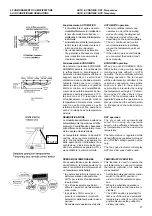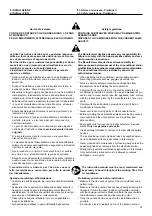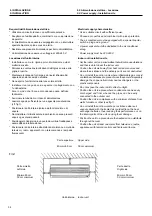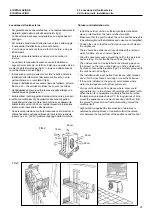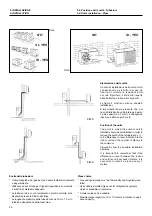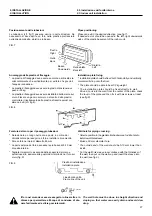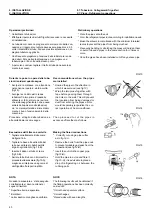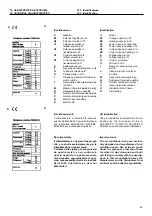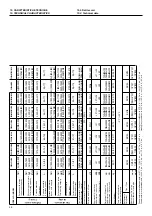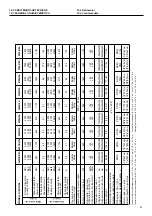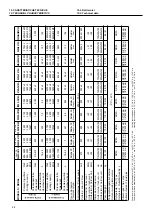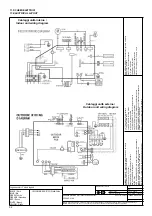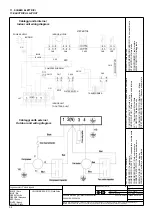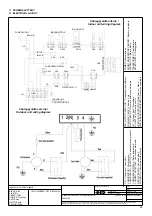
ATTENZIONE - E` importante che non cadano all'inter-
no dei tubi trucioli, polvere o altro perche` intasereb-
bero il circuito frigorifero all'altezza del capillare cau-
sando il blocco dell'impianto o il grippaggio del
compressore.
ATTENTION - It is important to prevent chips, dust or
other foreign bodes from dropping inside the pipes
since these would clog the refrigerating circuit at the
capillary causing the system to block or the compres-
sor to seize.
Connessione con le valvole.
* Rimuovere i dadi dalle tubazioni dell'unità interna.
* Rimuovere i tappi da entrambe le estremità delle tubazioni di
collegamento.
* Rimuovere i dadi dalle tubazioni dell'unità esterna.
* Versare un po` di olio frigorifero sulle estremità cartellate
delle tubature, quindi allineare le estremità cartellate alle
uscite e fissare bene i dadi.
Connection to valves
* Remove nuts from the pipes of the indoor unit.
* Remove plugs from both ends of the connecting pipes.
* Remove nuts from the pipes of the oudoor unit.
* Drop some refrigerating oil onto the flare fittings of both ends
of the pipes and tightly secure the nuts.
9. INSTALLAZIONE
9. INSTALLATION
9.8. Spurgo aria
9.8. Air purging
Spurgo aria
L'aria e l'umidità che rimangono all'interno del
sistema di refrigerazione hanno i seguenti
effetti indesiderabili.
• La pressione nel impianto aumenta.
• La corrente di esercizio aumenta.
• L'efficienza refrigerante (o di riscaldamento)
diminuisce.
• L'umidità nel circuito refrigerante può
gelare e bloccare i tubicini capillari.
• L'acqua può portare a fenomeni di corrosione
dei componenti nell'impianto refrigerante.
Di conseguenza il gruppo interno e i tubi posti
tra gruppo interno e gruppo esterno devono
essere collaudati per perdite e spurgati per
rimuovere elementi non condensanti e umidità
dal sistema.
Spurgo aria con pompa a vuoto
Preparazione
Verificare che ciascun tubo (sia i tubi laterali
del gas che del liquido) tra gruppo interno e
gruppo esterno siano stati collegati nel modo
corretto e che tutti i cablaggi necessari al col-
laudo siano stati effettuati. Rimuovere i cap-
pucci delle valvole di servizio sia dai lati gas
che liquido sul gruppo esterno. Prendere nota
del fatto che a questo punto che ambedue le
valvole di servizio dei lati gas e liquido del
gruppo interno vengono mantenute chiuse.
Test perdite
• Collegare la valvola manometro (con gli
indicatori di pressione) ed la bombola del
gas azoto all'apertura di servizio con i tubi di
carica.
Attenzione
Accertarsi di usare una valvola manometro
per lo spurgo d'aria. Se non è disponibile
usare una valvola di chiusura a questo scopo.
La manopola "Hi" della valvola manometro
Air purging
Air and moisture remaining in the refrigerant
system have undesirable effects as indicated
below.
• Pressure in the system rises.
• Operating current rises.
• Cooling(or heating) efficiency drops.
• Moisture in the refrigerant circuit may
freeze and block capillary tubing.
• Water may lead to corrosion of parts in
the refrigeration system.
Therefore, the indoor unit and tubing between
the indoor and outdoor unit must be leak
tested and evacuated to remove any non con-
densable and moisture from the system.
Air purging with vacuum pump
Preparation
Check that each tube(both liquid and gas side
tubes) between the indoor and outdoor units
have been properly connected and all wiring
for the test run has been completed. Remove
the service valve caps from both the gas and
the liquid side on the outdoor unit. Note that
both the liquid and the gas side service valves
on the outdoor unit are kept closed at this
stage.
Leak test
• Connect the manifold valve(with pres-
sure gauges) and dry nitrogen gas
cylinder to this service port with charge
hoses.
Caution
Be sure to use a manifold valve for air pur-
ging. If it is not available, use a stop valve for
this purpose. The "Hi" knob of the manifold
valve must always be kept close.
Indoor unit
Unità interna
Outdoor unit
Unità esterna
Valvola manometro
Manifold gauge
Indicatore di pressione
Pressure gauge
Tubo flessibile di carica
Charge hose
Bombola gas azoto
(nella posizione verticale)
Nitrogen gas cylinder
(in vertical position)
41

